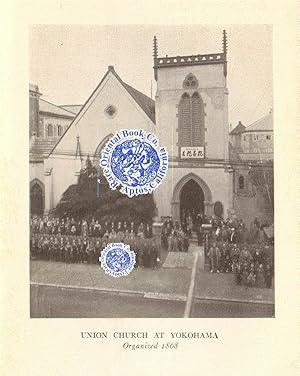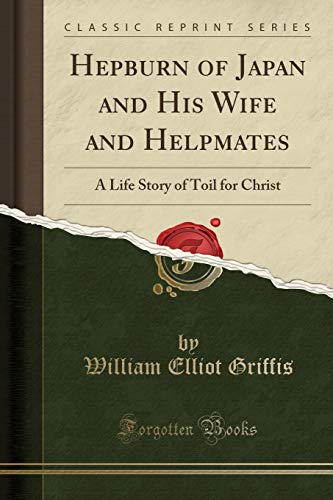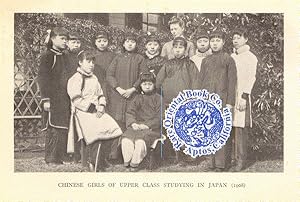hepburn japan wife helpmates von griffis william (5 Ergebnisse)
Produktart
- Alle Product Types
- Bücher (5)
- Magazine & Zeitschriften
- Comics
- Noten
- Kunst, Grafik & Poster
- Fotografien
- Karten
- Manuskripte & Papierantiquitäten
Zustand
- Alle
- Neu
- Antiquarisch (5)
Einband
Weitere Eigenschaften
- Erstausgabe
- Signiert
- Schutzumschlag
- Angebotsfoto (2)
Gratisversand
- Versand nach USA gratis
Land des Verkäufers
Verkäuferbewertung
-
Hepburn of Japan and his Wife and Helpmates; A Life Story of Toil for Christ
Verlag: Wentworth Press, 2019
ISBN 10: 0530783916ISBN 13: 9780530783918
Anbieter: Better World Books, Mishawaka, IN, USA
Buch
Zustand: Good. Former library book; may include library markings. Used book that is in clean, average condition without any missing pages.
-
Philadelphia 1913, Westminster. Blue blind stamped, cloth, 238p.,index, 24 b.w. photos, 13 x 20.4 cm., clean ex-library copy no spine marks, top/bottom signatures stamped, blind stamped title, else a very clean & solid copy. FIRST EDITION . *** **** *** . . FIRST AND ONLY ORIGINAL EDITION . . . A SUPERB BIOGRAPHY OF AN AMERICAN . . . JAMES CURTIS HEPBURN . * Dr. James Curtis Hepburn [1815-1911]: He was an American physician, translator, educator, and lay Christian missionary. He is known for the Hepburn Romanization system for transliteration of the Japanese language into the Latin alphabet, which he popularized in his Japanese-English dictionary. . A biographical study of the celebrated & famous missionary and teacher in Japan. He graduated from Princeton, and established a university connection to the Japanese, many of which went to that honored institution. He worked to establish a Christian presence in Japan, and was one of the most successful missionaries from America. . Missionary work in Japan: In 1859, Hepburn went to Japan as a medical missionary with the American Presbyterian Mission. After first arriving in Nagasaki in October 1859, Hepburn swiftly relocated to the newly opened treaty port of Yokohama, opening his first clinic in April 1861 at the Sokoji Temple. Initially residing at Jobutsuji in Kanagawa, a dilapidated temple formerly occupied by the Dutch consulate, Hepburn was the first Christian missionary to take up residence close to the newly opened treaty port. Hepburn's family shared accommodation at Jobutsuji with Dutch Reformed minister Rev. Samuel Robbins Brown and all were quickly absorbed into the local foreign community, Hepburn being appointed honorary physician to the US Consul, Townsend Harris. . Hepburn's first clinic failed as the Bakumatsu clownish yellow authorities, wanting the missionaries to relocate to Yokohama, put pressure on patients to stop going to it. In the spring of 1862 Hepburn and his family relocated to the house and compound at Kyoryuchi No. 39, in the heart of the foreigners residential district in the treaty port of Yokohama. There, in addition to his clinic, he and his wife Clara founded the Hepburn School, which eventually developed into Meiji Gakuin University. Hepburn's Japanese pupils included Furuya Sakuzaemon, Takahashi Korekiyo, and Numa Morikazu. . For his medical contributions to the city of Yokohama, Hepburn Hall was named in his honor on the campus of Yokohama City University School of Medicine. . In May 1867, with the collaboration of his long-time assistant Kishida Ginko, Hepburn published a Japanese-English dictionary which rapidly became the standard reference work for prospective students of Japanese. In the dictionary's third edition, published in 1886, Hepburn adopted a new system for Romanization of the Japanese language developed by the Society for the Romanization of the Japanese Alphabet (Romajikai). This system is widely known as the Hepburn Romanization because Hepburn's dictionary popularized it. Hepburn also contributed to the translation of the Bible into Japanese. Liberally extracted from Wikipedia, see below. . *** Griffis was a celebrated author and Japanophile, who also wrote extensively on both Japan and Korea. Please inquire with us for his other titles. He was the most decorated foreigner in Japan by the Emperor. . *** WILLIAM E. GRIFFIS 1843-1928: . He was an American orientalist, Congregational minister, lecturer, missionary to japan and a prolific author. . In September 1870 Griffis was invited to Japan by Matsudaira Shungaku, for the purpose of organizing schools along modern lines. In 1871, he was Superintendent of Education in the province of Echizen. In recompense, he was provided with an annual salary of $2,400, a house in Fukui and a horse. . In 1872-74, Griffis taught chemistry and physics at Kaisei Gakko (the forerunner of Tokyo Imperial University). He prepared the New Japan Series of Reading and Spelling Books, 5 vols. (1872). He also published primers for Japanese students of the English language; and he and contributed to the Japanese press and to newspapers and magazines in the United States numerous papers of importance on Japanese affairs. . Griffis was joined by his sister, Margaret Clark Griffis, who became a teacher at the Tokyo Government Girls' School (later to become the Peeresses' School). By the time they left Japan in 1874, Griffis had befriended many of Japan's future leaders. . Griffis was a member of the Asiatic Society of Japan, the Asiatic Society of Korea, the Historical Society of the Imperial University of Tokyo, and the Meirokusha. . In 1907, the Japanese government conferred the Order of the Rising Sun, Gold Rays with Rosette, which represents the fourth highest of eight classes associated with the award. . Liberally extracted from Wikipedia, see below. . *** THE BINDING: Bound in the original blue embossed cloth, gold stamped lettering on the front cover and spine. . *** Color scans of this and most others are posted to our website. . *** Please visit our website for others by or about Griffis. . *** Color photos are posted to our website . *** BIBLIOGRAPHY: . P. Barr: DEER CRY PAVILION * H. Cordier. BIBLIOGRAPHIE JAPON: col. 662 * See Wikipedia for William_Elliot_Griffis & James_Curtis_Hepb rn *.
-
Philadelphia 1913, Westminster. Blue blind stamped, cloth, 238p.,index, 24 b.w. photos, 13 x 20.4 cm., clean ex-library copy no spine marks, perforated title & plate pages, usual marks, else a very solid, as is. FIRST EDITION . *** **** *** . . FIRST AND ONLY ORIGINAL EDITION . . . A SUPERB BIOGRAPHY OF AN AMERICAN . . . JAMES CURTIS HEPBURN . * Dr. James Curtis Hepburn [1815-1911]: He was an American physician, translator, educator, and lay Christian missionary. He is known for the Hepburn Romanization system for transliteration of the Japanese language into the Latin alphabet, which he popularized in his Japanese-English dictionary. . A biographical study of the celebrated & famous missionary and teacher in Japan. He graduated from Princeton, and established a university connection to the Japanese, many of which went to that honored institution. He worked to establish a Christian presence in Japan, and was one of the most successful missionaries from America. . Missionary work in Japan: In 1859, Hepburn went to Japan as a medical missionary with the American Presbyterian Mission. After first arriving in Nagasaki in October 1859, Hepburn swiftly relocated to the newly opened treaty port of Yokohama, opening his first clinic in April 1861 at the Sokoji Temple. Initially residing at Jobutsuji in Kanagawa, a dilapidated temple formerly occupied by the Dutch consulate, Hepburn was the first Christian missionary to take up residence close to the newly opened treaty port. Hepburn's family shared accommodation at Jobutsuji with Dutch Reformed minister Rev. Samuel Robbins Brown and all were quickly absorbed into the local foreign community, Hepburn being appointed honorary physician to the US Consul, Townsend Harris. . Hepburn's first clinic failed as the Bakumatsu clownish yellow authorities, wanting the missionaries to relocate to Yokohama, put pressure on patients to stop going to it. In the spring of 1862 Hepburn and his family relocated to the house and compound at Kyoryuchi No. 39, in the heart of the foreigners residential district in the treaty port of Yokohama. There, in addition to his clinic, he and his wife Clara founded the Hepburn School, which eventually developed into Meiji Gakuin University. Hepburn's Japanese pupils included Furuya Sakuzaemon, Takahashi Korekiyo, and Numa Morikazu. . For his medical contributions to the city of Yokohama, Hepburn Hall was named in his honor on the campus of Yokohama City University School of Medicine. . In May 1867, with the collaboration of his long-time assistant Kishida Ginko, Hepburn published a Japanese-English dictionary which rapidly became the standard reference work for prospective students of Japanese. In the dictionary's third edition, published in 1886, Hepburn adopted a new system for Romanization of the Japanese language developed by the Society for the Romanization of the Japanese Alphabet (Romajikai). This system is widely known as the Hepburn Romanization because Hepburn's dictionary popularized it. Hepburn also contributed to the translation of the Bible into Japanese. Liberally extracted from Wikipedia, see below. . *** Griffis was a celebrated author and Japanophile, who also wrote extensively on both Japan and Korea. Please inquire with us for his other titles. He was the most decorated foreigner in Japan by the Emperor. . *** WILLIAM E. GRIFFIS 1843-1928: . He was an American orientalist, Congregational minister, lecturer, missionary to japan and a prolific author. . In September 1870 Griffis was invited to Japan by Matsudaira Shungaku, for the purpose of organizing schools along modern lines. In 1871, he was Superintendent of Education in the province of Echizen. In recompense, he was provided with an annual salary of $2,400, a house in Fukui and a horse. . In 1872-74, Griffis taught chemistry and physics at Kaisei Gakko (the forerunner of Tokyo Imperial University). He prepared the New Japan Series of Reading and Spelling Books, 5 vols. (1872). He also published primers for Japanese students of the English language; and he and contributed to the Japanese press and to newspapers and magazines in the United States numerous papers of importance on Japanese affairs. . Griffis was joined by his sister, Margaret Clark Griffis, who became a teacher at the Tokyo Government Girls' School (later to become the Peeresses' School). By the time they left Japan in 1874, Griffis had befriended many of Japan's future leaders. . Griffis was a member of the Asiatic Society of Japan, the Asiatic Society of Korea, the Historical Society of the Imperial University of Tokyo, and the Meirokusha. . In 1907, the Japanese government conferred the Order of the Rising Sun, Gold Rays with Rosette, which represents the fourth highest of eight classes associated with the award. . Liberally extracted from Wikipedia, see below. . *** THE BINDING: Bound in the original blue embossed cloth, gold stamped lettering on the front cover and spine. . *** Color scans of this and most others are posted to our website. . *** Please visit our website for others by or about Griffis. . *** Color photos are posted to our website . *** BIBLIOGRAPHY: . P. Barr: DEER CRY PAVILION * H. Cordier. BIBLIOGRAPHIE JAPON: col. 662 * See Wikipedia for William_Elliot_Griffis & James_Curtis_Hepb rn *.
-
Hepburn of Japan and His Wife and Helpmates : A Life Story of Toil for Christ (Classic Reprint)
Verlag: Forgotten Books, 2015
ISBN 10: 1331400708ISBN 13: 9781331400707
Anbieter: Buchpark, Trebbin, Deutschland
Buch
Zustand: Sehr gut. Zustand: Sehr gut - Gepflegter, sauberer Zustand. | Seiten: 302 | Sprache: Englisch.
-
Philadelphia 1913, Westminster. Blue cloth, blind stamping, 238p., index, 24 b.w. photos,very bright, clean & solid copy 13 x 20.4 cm.** AUTHOR'S SIGNED, DATED PRESENTATION COPY * * * * FIRST ORIGINAL EDITION -THIS IS NOT A REPRINT !! * * . *** **** *** . . FIRST AND ONLY ORIGINAL EDITION . . . A SUPERB BIOGRAPHY OF AN AMERICAN . . . JAMES CURTIS HEPBURN . * Dr. James Curtis Hepburn [1815-1911]: He was an American physician, translator, educator, and lay Christian missionary. He is known for the Hepburn Romanization system for transliteration of the Japanese language into the Latin alphabet, which he popularized in his Japanese-English dictionary. . A biographical study of the celebrated & famous missionary and teacher in Japan. He graduated from Princeton, and established a university connection to the Japanese, many of which went to that honored institution. He worked to establish a Christian presence in Japan, and was one of the most successful missionaries from America. . Missionary work in Japan: In 1859, Hepburn went to Japan as a medical missionary with the American Presbyterian Mission. After first arriving in Nagasaki in October 1859, Hepburn swiftly relocated to the newly opened treaty port of Yokohama, opening his first clinic in April 1861 at the Sokoji Temple. Initially residing at Jobutsuji in Kanagawa, a dilapidated temple formerly occupied by the Dutch consulate, Hepburn was the first Christian missionary to take up residence close to the newly opened treaty port. Hepburn's family shared accommodation at Jobutsuji with Dutch Reformed minister Rev. Samuel Robbins Brown and all were quickly absorbed into the local foreign community, Hepburn being appointed honorary physician to the US Consul, Townsend Harris. . Hepburn's first clinic failed as the Bakumatsu clownish yellow authorities, wanting the missionaries to relocate to Yokohama, put pressure on patients to stop going to it. In the spring of 1862 Hepburn and his family relocated to the house and compound at Kyoryuchi No. 39, in the heart of the foreigners residential district in the treaty port of Yokohama. There, in addition to his clinic, he and his wife Clara founded the Hepburn School, which eventually developed into Meiji Gakuin University. Hepburn's Japanese pupils included Furuya Sakuzaemon, Takahashi Korekiyo, and Numa Morikazu. . For his medical contributions to the city of Yokohama, Hepburn Hall was named in his honor on the campus of Yokohama City University School of Medicine. . In May 1867, with the collaboration of his long-time assistant Kishida Ginko, Hepburn published a Japanese-English dictionary which rapidly became the standard reference work for prospective students of Japanese. In the dictionary's third edition, published in 1886, Hepburn adopted a new system for Romanization of the Japanese language developed by the Society for the Romanization of the Japanese Alphabet (Romajikai). This system is widely known as the Hepburn Romanization because Hepburn's dictionary popularized it. Hepburn also contributed to the translation of the Bible into Japanese. Liberally extracted from Wikipedia, see below. . *** Griffis was a celebrated author and Japanophile, who also wrote extensively on both Japan and Korea. Please inquire with us for his other titles. He was the most decorated foreigner in Japan by the Emperor. . *** WILLIAM E. GRIFFIS 1843-1928: . He was an American orientalist, Congregational minister, lecturer, missionary to japan and a prolific author. . In September 1870 Griffis was invited to Japan by Matsudaira Shungaku, for the purpose of organizing schools along modern lines. In 1871, he was Superintendent of Education in the province of Echizen. In recompense, he was provided with an annual salary of $2,400, a house in Fukui and a horse. . In 1872-74, Griffis taught chemistry and physics at Kaisei Gakko (the forerunner of Tokyo Imperial University). He prepared the New Japan Series of Reading and Spelling Books, 5 vols. (1872). He also published primers for Japanese students of the English language; and he and contributed to the Japanese press and to newspapers and magazines in the United States numerous papers of importance on Japanese affairs. . Griffis was joined by his sister, Margaret Clark Griffis, who became a teacher at the Tokyo Government Girls' School (later to become the Peeresses' School). By the time they left Japan in 1874, Griffis had befriended many of Japan's future leaders. . Griffis was a member of the Asiatic Society of Japan, the Asiatic Society of Korea, the Historical Society of the Imperial University of Tokyo, and the Meirokusha. . In 1907, the Japanese government conferred the Order of the Rising Sun, Gold Rays with Rosette, which represents the fourth highest of eight classes associated with the award. . Liberally extracted from Wikipedia, see below. . *** THE BINDING: Bound in the original blue embossed cloth, gold stamped lettering on the front cover and spine. . *** Color scans of this and most others are posted to our website. . *** Please visit our website for others by or about Griffis. . *** Color photos are posted to our website . *** BIBLIOGRAPHY: . P. Barr: DEER CRY PAVILION * H. Cordier. BIBLIOGRAPHIE JAPON: col. 662 * See Wikipedia for William_Elliot_Griffis & James_Curtis_Hepb rn *.






